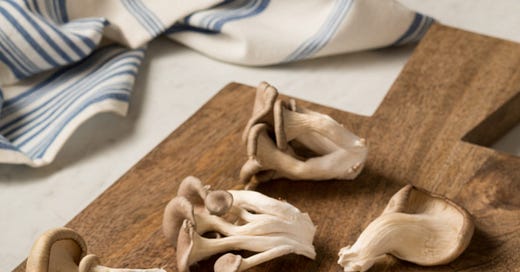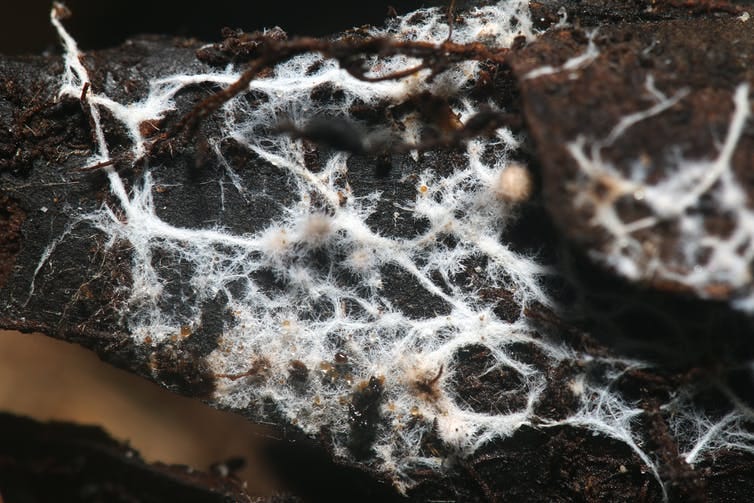All About the Amazing Oyster Mushroom, Including How to Prep and Use It in Your Cooking
As we reach the close of the second week in February, I can’t help but begin to get excited for the snow to melt here in the midwest, which once gone only means one thing for the Iowa Fun-gui’s — Mushroom Season! And what better way to kick off issue number 23 than with a full overview of the mushroom we’re planning to kick off our business with this spring, the Oyster Mushroom!
First, a bit of history… not long ago, in the late 20th century, the only mushroom you could find in a U.S. supermarket was the button mushroom. After that, portobellos arrived, and then shiitakes crept in. By the 2000s, there was however a clear shift: The gourmet mushroom boom began as technology to cultivate them evolved and demand grew. Fresh oyster mushrooms, previously a wild-only edible fungus, are now within a curious cook's reach. They are delicious, nutritious, and readily available at major grocery chains as well as at farmers' markets.
In the Wild
In the wild, oyster mushrooms grow in overlapping shelves on logs or living trees. They digest organic matter, and they cause a white rot that kills hardwood trees. Their stems are often lateral (growing to the side) and are short and stout. White gills extend partially down those stems. They are impervious to seasonal shifts and you may find them on a muggy summer afternoon or in the middle of winter, as long as there has been some rain.
Cultivated Oyster Mushrooms
Once cultivated only in East Asia, American production increased earlier this century as interest in oysters grew. Commercially-produced oyster mushrooms are grown from mycelium that is propagated on a base of cereal grain. This mixture is called spawn and is used to inoculate the substrate, which the mushrooms feed on. They can grow on any organic matter that contains cellulose; in the U.S., the substrate is usually a mix of straw and cottonseed hulls packed into perforated bags. The bags are placed in a warm, dark environment to incubate and begin the first phase of growth. After about two weeks, when the spawn has colonized the substrate, the bags are exposed to light, high humidity, and sometimes cooler temperatures. This provokes fruiting, when mushrooms form, starting as pinhead-sized caps. They are ready to harvest after about a week.
How To Eat Oyster Mushrooms
Cooked oyster mushrooms have a savory flavor and a dense texture, making them a versatile ingredient. Know that because the cell walls of all raw mushrooms contain indigestible chitin, oyster mushrooms should be cooked. Oysters contain a protein called ostreolysin, which can be toxic unless the mushrooms are cooked at temperatures above 140 degrees Fahrenheit, according to mushroom guru Paul Stamets. Small oyster mushrooms can be cooked whole, or dropped into soup (where they are slippery and, well, oyster-like), while large ones can be sliced or seared entire for a wonderful vegan steak. When sautéed, their flavor concentrates and becomes rich. Cook them gently in butter or your favorite oil, taste, and season lightly. Pan-cooked, they are excellent sandwich fillers, egg-toppings, and delicious substitutes for ground meat in dishes ranging from mapo tofuto lasagna. And if you love bacon but tend to follow a vegan diet, the New York-based mycelium-innovator Ecovative and their food partner have developed a vegan bacon called MyBacon, based on oyster mushrooms, rather than meat.
While traditional medicine has long touted the health benefits of mushrooms, science is still catching up in terms of proven results. Still, oyster mushrooms are demonstrably antibiotic, and are associated with antiviral activity, and cholesterol-limiting properties.
Unusual and Amazing Oyster Mushroom Facts
Oyster mushrooms are carnivorous! They ensnare and digest nematodes (tiny worms), which can make them higher in protein than you'd think. Their cellulose-digesting enzymes mean they are able to absorb, sequester, or destroy pollutants, and potentially useful in clean-ups ranging from clearing oil spills to breaking down disposable diapers. And they convert substrates like straw into water in their fruiting bodies, making them very interesting in a world facing clean water insecurity.
Squirrels Are Somehow Surviving After Eating Poisonous Mushrooms
Now here’s a crazy story… Squirrels in Japan have been found repeatedly eating highly poisonous mushrooms that could harm them, leaving a scientist and photographer who observed them stumped.
In the image above, we can see a Japanese squirrel eating different species of amanita mushrooms, which are poisonous to humans and many animals. When consumed by humans, the mushrooms can cause delirium, hallucinations, seizures, comas and even death in some cases.
The scientist and photographer who documented the squirrel behavior said in the journal entry that the animals returned to eat the poisonous fungi over several days, suggesting that they could consume them safely.
The visual distortion of objects is one common symptom of consuming the mushroom which, as the authors of the research noted, informed the hallucinatory elements in Lewis Carrol's 1865 novel Alice's Adventures in Wonderland. The protagonist is given some mushroom to eat in the book.
"I was genuinely surprised. I was afraid the squirrel might get an upset stomach," Kenju Suetsugu, associate professor of Kobe University told Newsweek. "But, the same individual squirrel returned a few days later to continue feeding on a panther cap mushroom, leading us to conclude that it is highly probable that these squirrels can safely consume poisonous mushrooms."
The authors said their observations suggest there is a symbiotic relationship between the squirrels and toxic mushrooms. Not only do the squirrels likely benefit from eating the mushrooms, but they could be helping distribute mushroom spores too.
At the present time, the symbiotic relationship between the squirrels and mushrooms is hypothetical, however. The research poses numerous questions warranting further study, the authors said.
How can squirrels survive eating toxins "deserves future study. As it stands, we cannot answer the question," Suetsugu said.
Fungi: the missing link in tree planting schemes
And for our final feature of this week, let’s cover the symbiotic relationship between fungi and trees in an effort to slow climate change. In this effort, the UK government aims to plant enough trees to expand the country’s woodland cover from 13% to 20% by 2050. Creating healthy woodlands on this scale is an enormous challenge, but forestry experts have developed guidance which, if followed, ought to give these new habitats the greatest chance of success.
It is really important that the right trees are planted in the right places. Choosing trees that are well suited to the habitat means they will grow better, be less prone to disease, and provide plentiful food and habitats for other organisms, such as lichens and insects.
In addition to focusing on where to plant trees, its also vitally important to consider how fungi can benefit this situation. Fungi belong to an entirely separate kingdom of life from plants and animals and are found in every habitat on Earth. Beneficial mycorrhizal fungi form close relationships with trees, growing around or within their roots. Fungi harvest nutrients such as nitrogen and phosphorus from the soil and deliver them to the tree in exchange for carbon-rich sugars generated via photosynthesis.
The trees use their nutrients to make essential compounds such as chlorophyll, and the fungi convert their sugars into long-term stores in the soil which can hold up to 20% of the carbon taken up by trees. Fungi also control most decomposition in forests, breaking down compounds in leaves and dead wood that no other organisms can digest. Without fungi, forest systems simply would not function.
The fungus among us
Fungal friends in forests should not be ignored. We need to maximize the benefits of beneficial fungi by protecting fungal diversity. Ancient woodlands and veteran trees are important habitats for lots of vital and rare fungi. Their rich fungal communities can disperse and populate new woodlands, helping to develop friendly mycorrhizal and decomposer networks in new forests.
Remembering fungi in this new era of woodland creation will enable our forests, and the people in them, to be as healthy and resilient as possible.
Thank you for reading this weeks edition of Fungi Friday’s! If you enjoyed what you found, please feel free to forward to friends also interested in the Fungi Community!
Connect with me on Twitter @BowTiedMushroom
And if you were forwarded this post and enjoyed what you found, please subscribe below:




